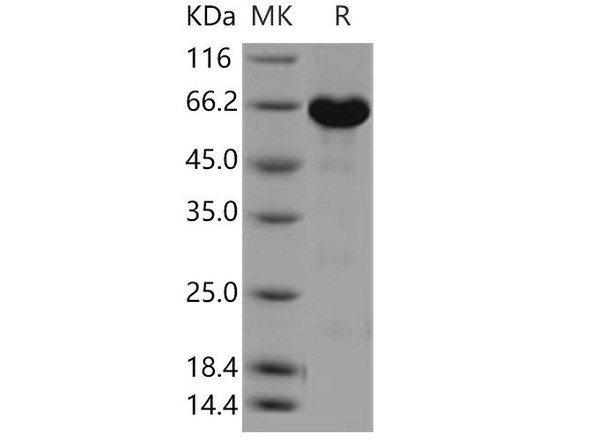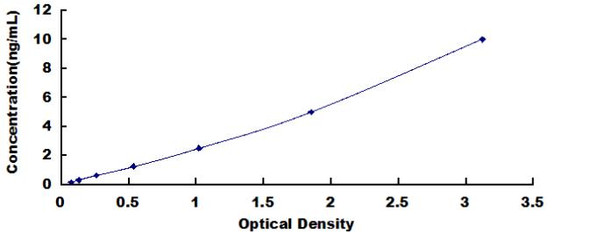Human MAPK12 Recombinant Protein (RPPB2573)
- SKU:
- RPPB2573
- Product Type:
- Recombinant Protein
- Species:
- Human
- Uniprot:
- P53778
- Research Area:
- Enzymes
Description
| Product Name: | Human MAPK12 Recombinant Protein |
| Product Code: | RPPB2573 |
| Size: | 20µg |
| Species: | Human |
| Target: | MAPK12 |
| Synonyms: | Mitogen-activated protein kinase 12, SAPK3, ERK6, PRKM12, Extracellular signal-regulated kinase 6, Mitogen-activated protein kinase p38 gamma, Stress-activated protein kinase 3, MAP kinase 12, MAP kinase p38 gamma, MAPK 12, ERK3, p38gamma, EC 2.7.11.24, EC 2.7.11. |
| Source: | Escherichia Coli |
| Physical Appearance: | Sterile Filtered colorless solution. |
| Formulation: | MAPK12 protein solution (0.5mg/ml) containing 20mM Tris-HCl buffer (pH8.0), 100mM NaCl, 1mM DTT and 10% glycerol. |
| Stability: | Store at 4°C if entire vial will be used within 2-4 weeks.Store, frozen at -20°C for longer periods of time. For long term storage it is recommended to add a carrier protein (0.1% HSA or BSA).Avoid multiple freeze-thaw cycles. |
| Purity: | Greater than 95.0% as determined by SDS-PAGE analysis. |
| Amino Acid Sequence: | MGSSHHHHHH SSGLVPRGSH MSSPPPARSG FYRQEVTKTA WEVRAVYRDL QPVGSGAYGA VCSAVDGRTG AKVAIKKLYR PFQSELFAKR AYRELRLLKH MRHENVIGLL DVFTPDETLD DFTDFYLVMP FMGTDLGKLM KHEKLGEDRI QFLVYQMLKG LRYIHAAGII HRDLKPGNLA VNEDCELKIL DFGLARQADS EMTGYVVTRW YRAPEVILNW MRYTQTVDIW SVGCIMAEMI TGKTLFKGSD HLDQLKEIMK VTGTPPAEFV QRLQSDEAKN YMKGLPELEK KDFASILTNA SPLAVNLLEK MLVLDAEQRV TAGEALAHPY FESLHDTEDE PQVQKYDDSF DDVDRTLDEW KRVTYKEVLS FKPPRQLGAR VSKETPL |
MAPK12 is a member of the MAP kinase family. MAPK12 acts as a signal transducer during differentiation of myoblasts to myotubes. p38 proteins utilizes magnesium as a cofactor to catalyze the ATP-dependent phosphorylation of target proteins and is produced in several regions all over the body with common expression patterns in heart.
MAPK12 Human Recombinant produced in E.Coli is a single, non-glycosylated polypeptide chain containing 387 amino acids (1-367 a.a.) and having a molecular mass of 44.1kDa.MAPK12 is fused to a 20 amino acid His-tag at N-terminus & purified by proprietary chromatographic techniques.
| UniProt Protein Function: | Function: Serine/threonine kinase which acts as an essential component of the MAP kinase signal transduction pathway. MAPK12 is one of the four p38 MAPKs which play an important role in the cascades of cellular responses evoked by extracellular stimuli such as proinflammatory cytokines or physical stress leading to direct activation of transcription factors such as ELK1 and ATF2. Accordingly, p38 MAPKs phosphorylate a broad range of proteins and it has been estimated that they may have approximately 200 to 300 substrates each. Some of the targets are downstream kinases such as MAPKAPK2, which are activated through phosphorylation and further phosphorylate additional targets. Plays a role in myoblast differentiation and also in the down-regulation of cyclin D1 in response to hypoxia in adrenal cells suggesting MAPK12 may inhibit cell proliferation while promoting differentiation. Phosphorylates DLG1. Following osmotic shock, MAPK12 in the cell nucleus increases its association with nuclear DLG1, thereby causing dissociation of DLG1-SFPQ complexes. This function is independent of its catalytic activity and could affect mRNA processing and/or gene transcription to aid cell adaptation to osmolarity changes in the environment. Regulates UV-induced checkpoint signaling and repair of UV-induced DNA damage and G2 arrest after gamma-radiation exposure. MAPK12 is involved in the regulation of SLC2A1 expression and basal glucose uptake in L6 myotubes; and negatively regulates SLC2A4 expression and contraction-mediated glucose uptake in adult skeletal muscle. C-Jun (JUN) phosphorylation is stimulated by MAPK14 and inhibited by MAPK12, leading to a distinct AP-1 regulation. MAPK12 is required for the normal kinetochore localization of PLK1, prevents chromosomal instability and supports mitotic cell viability. MAPK12-signaling is also positively regulating the expansion of transient amplifying myogenic precursor cells during muscle growth and regeneration. Ref.1 Ref.6 Ref.9 Ref.12 Ref.14 Ref.15 Ref.17 |
| UniProt Protein Details: | Catalytic activity: ATP + a protein = ADP + a phosphoprotein. Cofactor: Binds 2 magnesium ions. Ref.20 Enzyme regulation: Activated by phosphorylation on threonine and tyrosine. MAP2K3/MKK3 and MAP2K6/MKK6 are both essential for the activation of MAPK12 induced by environmental stress, whereas MAP2K6/MKK6 is the major MAPK12 activator in response to TNF-alpha. Ref.6 Ref.7 Subunit structure: Monomer. Interacts with the PDZ domain of the syntrophin SNTA1. Interacts with SH3BP5. Interacts with LIN7C, SCRIB and SYNJ2BP By similarity. Ref.7 Ref.11 Ref.20 Subcellular location: Cytoplasm. Nucleus. Mitochondrion. Note: Mitochondrial when associated with SH3BP5. In skeletal muscle colocalizes with SNTA1 at the neuromuscular junction and throughout the sarcolemma By similarity. Ref.10 Ref.11 Ref.14 Tissue specificity: Highly expressed in skeletal muscle and heart. Ref.1 Ref.10 Induction: Expression of MAPK12 is down-regulation by MAPK14 activation. Ref.6 Ref.7 Ref.14 Domain: The TXY motif contains the threonine and tyrosine residues whose phosphorylation activates the MAP kinases. Post-translational modification: Dually phosphorylated on Thr-183 and Tyr-185 by MAP2K3/MKK3 and MAP2K6/MKK6, which activates the enzyme. Ref.8 Ref.14Ubiquitinated. Ubiquitination leads to degradation by the proteasome pathway. Ref.14 Involvement in Disease: MAPK is overexpressed in highly metastatic breast cancer cell lines and its expression is preferentially associated with basal-like and metastatic phenotypes of breast tumor samples. Sequence similarities: Belongs to the protein kinase superfamily. CMGC Ser/Thr protein kinase family. MAP kinase subfamily.Contains 1 protein kinase domain. Biophysicochemical propertiesKinetic parameters:KM=37 �M for ATP Ref.7KM=313 �M for EGFR substrate peptideKM=254 �M for GST-ATF2 |
| NCBI Summary: | Activation of members of the mitogen-activated protein kinase family is a major mechanism for transduction of extracellular signals. Stress-activated protein kinases are one subclass of MAP kinases. The protein encoded by this gene functions as a signal transducer during differentiation of myoblasts to myotubes. [provided by RefSeq, Jul 2008] |
| UniProt Code: | P53778 |
| NCBI GenInfo Identifier: | 2851522 |
| NCBI Gene ID: | 6300 |
| NCBI Accession: | P53778.3 |
| UniProt Secondary Accession: | P53778,Q14260, Q99588, Q99672, |
| UniProt Related Accession: | P53778 |
| Molecular Weight: | 41,940 Da |
| NCBI Full Name: | Mitogen-activated protein kinase 12 |
| NCBI Synonym Full Names: | mitogen-activated protein kinase 12 |
| NCBI Official Symbol: | MAPK12�� |
| NCBI Official Synonym Symbols: | ERK3; ERK6; SAPK3; PRKM12; SAPK-3; P38GAMMA�� |
| NCBI Protein Information: | mitogen-activated protein kinase 12; ERK-6; MAPK 12; MAP kinase 12; MAP kinase p38 gamma; stress-activated protein kinase 3; mitogen-activated protein kinase 3; extracellular signal-regulated kinase 6; mitogen-activated protein kinase p38 gamma |
| UniProt Protein Name: | Mitogen-activated protein kinase 12 |
| UniProt Synonym Protein Names: | Extracellular signal-regulated kinase 6; ERK-6; Mitogen-activated protein kinase p38 gamma; MAP kinase p38 gamma; Stress-activated protein kinase 3 |
| UniProt Gene Name: | MAPK12�� |
| UniProt Entry Name: | MK12_HUMAN |








